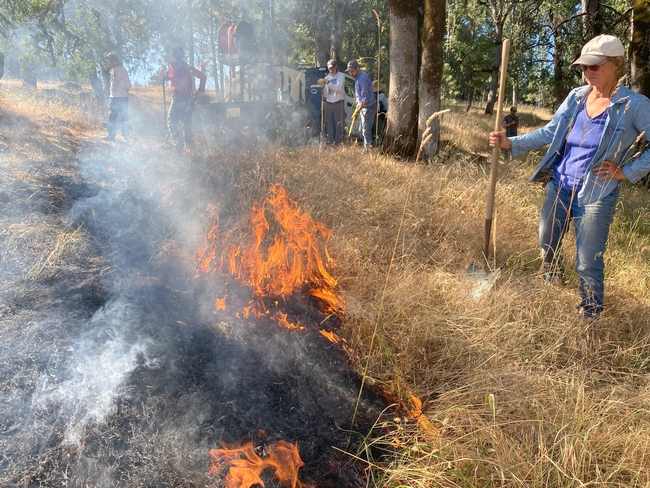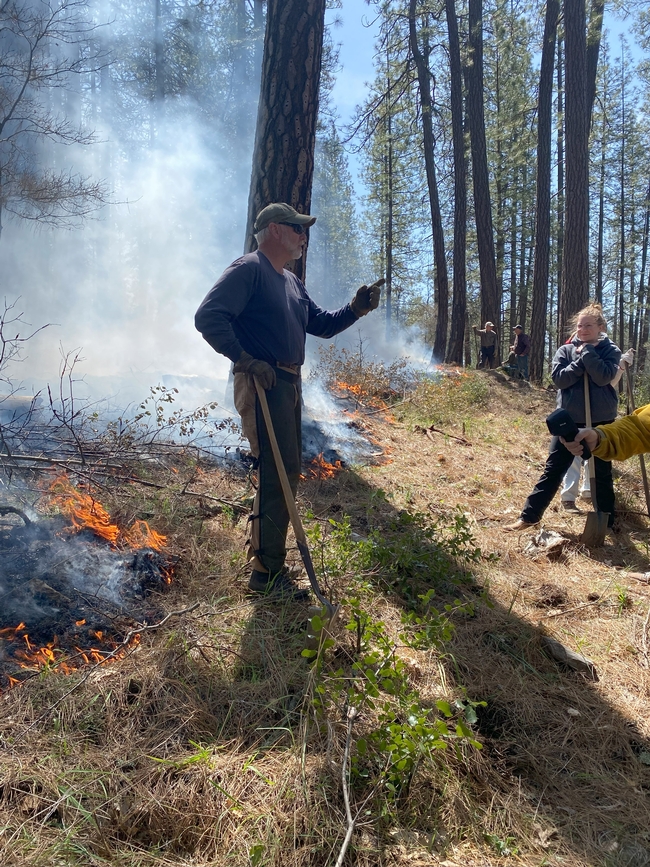Barb goatgrass (Aegilops triuncialis L.) is a winter annual grass native to the Mediterranean region and western Asia. According to a UCANR publication, it was introduced to Sacramento and El Dorado Counties via the importation of cattle from Mexico. And it is a growing problem on annual rangelands here in the Sierra Foothills. In some ways, I think of this invasive grass as "medusahead on steroids" - barb goatgrass spikes and joints (seedheads) disperse by attaching to animals, humans, and equipment. I often see new infestations along roads or walkways. Barb goatgrass forms dense stands with a rapidly establishing root system, making it extremely competitive with other annual grasses and forbs. In some areas, barb goatgrass reduces forage quality and quantity by as much as 75 percent - and because livestock tend to avoid the plant (and graze more desirable forages), it can spread rapidly.
Carol and Andy Kramer, who operate a sheep and cattle ranch in Nevada County, have been fighting barb goatgrass for several years. Most recently, they've been working with the Natural Resource Conservation Service (NRCS) through an Environmental Quality Incentives Program contract focused on goatgrass control. Over the course of the last 9 months, Carol and Andy have been working with the Placer Resource Conservation District (RCD) and UCCE to experiment with using prescribed fire to reduce goatgrass and re-invigorate native grasses.
Research suggests that burning goatgrass for two consecutive years offers "excellent control." Sounds pretty straightforward, right?! Not so fast! Fire is an effective control method when most of the fine fuel has dried sufficiently to carry the fire, but when the goatgrass seedheads are still attached to the stem - in other words, in late spring or early summer, when everyone is starting to get nervous about fire in the foothills!
A quick aside about using prescribed fire as a range improvement tool. When I started working with ranchers in California in the early 1990s (when I was just out of college, working for the California Cattlemen's Association), prescribed fire had largely gone out of vogue. This was partly a result of increasing worries about liability, and partly, as I recall, a shift in focus and attitude within the California Department of Forestry and Fire Protection (which became officially known as CalFire in the early 2000s). Today, after a decade of increasingly catastrophic wildfires (and the accelerating spread of invasive weeds like barb goatgrass), prescribed fire is making a comeback - thanks to efforts of many of my UCCE colleagues, RCD staffers and contractors like Cordi Craig and Chris Paulus (who led this effort), and especially of landowners like Carol and Andy!
Obviously, with something as complicated as prescribed burning, you don't simply wake up one June morning and say, "Hey, this would be a great day to light the back pasture on fire!" Carol and Andy (along withCordi and Chris, andUCCE) began planning for this burn last winter. As fire professionals,Cordi and Chris recommended putting a "black line" around the 1.5 acres ofgoatgrass during the winter months, whenCALFIRE burn permits are not required. Carol and Andy invested in water tanks and other equipment, and spent much of the winter and early spring pile burning and creating fire lines. Working together, we also burned several adjacent units to remove ground and ladder fuels in the areas surrounding thegoatgrass site.
Then we all waited! We needed the underlying fuel to be dry enough to burn, but we also needed the goatgrass to hold onto its seedheads. And we needed the right weather conditions. With the wet, cool spring we had in 2023, these conditions didn't arrive until July - well into fire season. This meant that we also needed a permit from CalFire. I've lived and worked in CalFire's NEU unit (which covers Placer, Nevada, and Yuba Counties) - and worked with and around ranchers - for nearly 30 years. I wasn't aware of CalFire ever allowing a rancher to do a prescribed fire for range improvement (or any other reason) in July. But thanks to the Kramer's persistence and Cordi and Chris's experience and knowledge, we received permission to do the burn on July 13.
Carol and Andy started the fire around 9am that morning - temperatures were hovering around 80F, and the relative humidity was just over 50%. Amazingly, we had difficulty getting the vegetation to burn - even as temperatures rose and humidity dropped over the course of the morning. By midday, we'd burned all we could burn, and began mopping up (making sure the fire was completely out).
Walking through the burn, I was amazed by the variability in burn intensity. Some of the goatgrass seedheads were completely consumed; others looked like they had not been exposed to fire at all. Carol collected seedheads from before the burn, as well as singed and apparently unsinged seedheads, to see if there will be any difference in germination (we'll keep you posted). We also started thinking about next year's burn.
One of the biggest challenges in burning for a second consecutive year, I expect, will be whether there is enough fine fuel (other grasses, pine needles, dry leaves, etc.) to carry the fire through the goatgrass. Visiting the site two weeks ago, I was impressed to see native blue wildrye starting to grow in the blackened burn unit (even with very little precipitation since the fire) - we'll be anxious to see what happens once we've had a germinating rain. Even so, we are considering broadcasting a quick-growing, early maturing annual grass (like soft chess (Bromus hordeaceus) this fall so that we have more receptive fuel next spring.
I think we all learned a great deal about the logistics of using fire to manage goatgrass (thanks to Cordi and Chris) - and about the challenges of using prescribed fire during fire season. One of the side benefits, from my perspective, is the demystification of fire generally. This was not a scary burn, even though it happened in the middle of July! While this was partly due to the conditions on the day of the burn, the work that Carol and Andy did to prepare (with Cordi and Chris's guidance) over the many months leading up to July 13 made it successful and safe. We're all looking forward to next year's fire!

